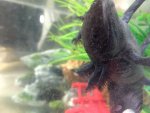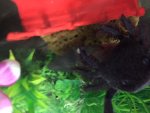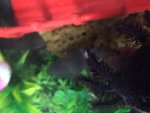Zero of everything actually isn't an indication that the tank is cycled. The ideal reading is zero ammonia, zero nitrite, and a very low reading of nitrate. In a cycled tank, there will always be a little bit of nitrate because there's no bacteria that removes it. It's only removed through water changes and live plants if you have them. I'm not saying your tank ISN'T cycled, and even if it's not, that isn't the definite cause of a fungus. It can actually just happen kind of randomly as well. My tank has never been warmer than about 64 or 65 F, and I pre-cycled with goldfish, but one of my axolotls got a fungal infection (at least that's what it looked like) after he was bitten, and he ended up quickly dying from it. I don't say that to scare you. Most of the time fungal infections go away on their own, especially with cautious treatments.
There are different treatment options. General consensus is that tea tree leaf extract is fine, and even putting in a tea bag can help (or just putting them in a separate bowl of cold water WITH a tea bag, for 10 or 15 minutes). Salt baths are slightly more aggressive. If you want to try something cautious, do a tea bag treatment once or twice a day, or you could consider buying Pimafix (which a fungal treatment that's basically just tea tree leaf extract in a bottle).
HOWEVER, you also need to try to get your tank temperature down a little. If you don't already have one, set up a small fan blowing on the surface of the water (and make sure you don't have a solid lighted lid like what comes with a fish tank--screen lids are pretty much ideal).
I would guess that your tank is not cycled (but it depends on how long you've had your axolotl in there). The definite good news though is that your test is showing there's not ammonia or nitrite since those are what are actually pretty toxic. A lack of nitRATE though might mean you're really lucky that there's no ammonia or nitrite since they are converted to nitrate, the least harmful nitrogen compound. Do a 10 or 20% water change every day for a few days until you see 0 ammonia, 0 nitrite, and a small amount of nitrate.
Low pH and slightly high temperature could definitely be factors in a fungal infection. Good luck! Let us know what happens.



